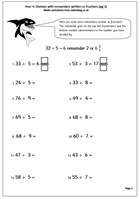Division nearly always requires carrying out more than one process, which makes it harder for children to process. A good knowledge of tables is also needed to complete division questions successfully, and this is especially true when there are remainders.
For example: to find the answer to 37 divided by 5: ask how many fives are in 37. This is where the knowledge of tables comes in, as 5 x 7 makes 35.
Then a subtraction take 35 from 37 to leave 2. There is a remainder of 2. (The remainder can never be bigger than the number you are dividing by.)
This remainder can be converted to a fraction. The 2 is the numerator (top number) and the denominator (bottom number) is the number you are dividing by, in this case 5. So the fraction left is 2/5.
This is a much neater finish to the question as the whole number is divided completely, with no messy remainders. Some of the fractions could be cancelled down to their simplest form, although this is not essential at this stage.
